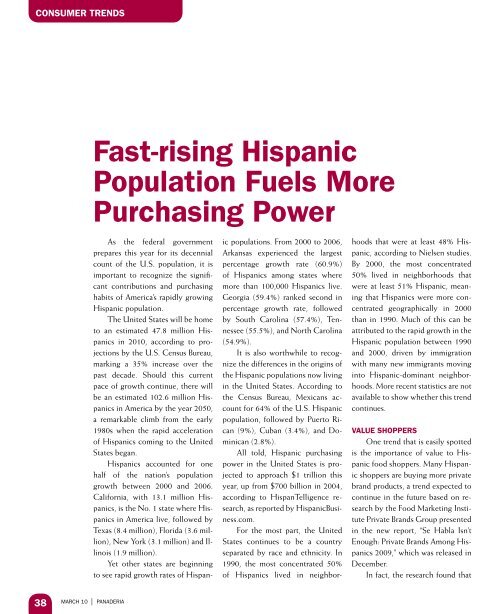Create Signature Cakes Crea Pasteles Distintivos - Your BakeMark
Create Signature Cakes Crea Pasteles Distintivos - Your BakeMark
Create Signature Cakes Crea Pasteles Distintivos - Your BakeMark
You also want an ePaper? Increase the reach of your titles
YUMPU automatically turns print PDFs into web optimized ePapers that Google loves.
CONSUMER TRENDS<br />
38 MARCH 10 | PANADERIA<br />
Fast-rising Hispanic<br />
Population Fuels More<br />
Purchasing Power<br />
As the federal government<br />
prepares this year for its decennial<br />
count of the U.S. population, it is<br />
important to recognize the significant<br />
contributions and purchasing<br />
habits of America’s rapidly growing<br />
Hispanic population.<br />
The United States will be home<br />
to an estimated 47.8 million Hispanics<br />
in 2010, according to projections<br />
by the U.S. Census Bureau,<br />
marking a 35% increase over the<br />
past decade. Should this current<br />
pace of growth continue, there will<br />
be an estimated 102.6 million Hispanics<br />
in America by the year 2050,<br />
a remarkable climb from the early<br />
1980s when the rapid acceleration<br />
of Hispanics coming to the United<br />
States began.<br />
Hispanics accounted for one<br />
half of the nation’s population<br />
growth between 2000 and 2006.<br />
California, with 13.1 million Hispanics,<br />
is the No. 1 state where Hispanics<br />
in America live, followed by<br />
Texas (8.4 million), Florida (3.6 million),<br />
New York (3.1 million) and Illinois<br />
(1.9 million).<br />
Yet other states are beginning<br />
to see rapid growth rates of Hispan-<br />
ic populations. From 2000 to 2006,<br />
Arkansas experienced the largest<br />
percentage growth rate (60.9%)<br />
of Hispanics among states where<br />
more than 100,000 Hispanics live.<br />
Georgia (59.4%) ranked second in<br />
percentage growth rate, followed<br />
by South Carolina (57.4%), Tennessee<br />
(55.5%), and North Carolina<br />
(54.9%).<br />
It is also worthwhile to recognize<br />
the differences in the origins of<br />
the Hispanic populations now living<br />
in the United States. According to<br />
the Census Bureau, Mexicans account<br />
for 64% of the U.S. Hispanic<br />
population, followed by Puerto Rican<br />
(9%), Cuban (3.4%), and Dominican<br />
(2.8%).<br />
All told, Hispanic purchasing<br />
power in the United States is projected<br />
to approach $1 trillion this<br />
year, up from $700 billion in 2004,<br />
according to HispanTelligence research,<br />
as reported by HispanicBusiness.com.<br />
For the most part, the United<br />
States continues to be a country<br />
separated by race and ethnicity. In<br />
1990, the most concentrated 50%<br />
of Hispanics lived in neighbor-<br />
hoods that were at least 48% Hispanic,<br />
according to Nielsen studies.<br />
By 2000, the most concentrated<br />
50% lived in neighborhoods that<br />
were at least 51% Hispanic, meaning<br />
that Hispanics were more concentrated<br />
geographically in 2000<br />
than in 1990. Much of this can be<br />
attributed to the rapid growth in the<br />
Hispanic population between 1990<br />
and 2000, driven by immigration<br />
with many new immigrants moving<br />
into Hispanic-dominant neighborhoods.<br />
More recent statistics are not<br />
available to show whether this trend<br />
continues.<br />
ValUE SHOPPERS<br />
One trend that is easily spotted<br />
is the importance of value to Hispanic<br />
food shoppers. Many Hispanic<br />
shoppers are buying more private<br />
brand products, a trend expected to<br />
continue in the future based on research<br />
by the Food Marketing Institute<br />
Private Brands Group presented<br />
in the new report, “Se Habla Isn’t<br />
Enough: Private Brands Among Hispanics<br />
2009,” which was released in<br />
December.<br />
In fact, the research found that



